County tastes Bell-style politics
August 10, 2010
Long before the revelations of stratospheric salaries, the residents of Bell were seething—as Arlene Barrera can tell you.
A top property tax official in the L.A. County Auditor-Controller’s Office, Barrera and a colleague were featured speakers at a May meeting of the grassroots Bell Resident Club. Their appearance was arranged by a woman who, in an e-mail to the county, said: “I cannot sleep at night, I cry all the time.” Property taxes, she said, were rising so rapidly in the working-class town that residents were being ruined.
On the night of the meeting in a rundown community center, Barrera felt their pain. “We need your help,” they told her. “A lot of our neighbors are losing their homes. They can’t afford the taxes.”
Barrera by then had seen those tax bills—the doubling of assessments by Bell, the extraordinary level of bond and pension debt for such a small and poor populace. “It was ridiculous,” Barrera says. But she could offer little direct relief to the residents, at least for the moment. These were city, not county, matters, she told them. The county mails the bills but the municipalities control them.
“The crowd was very angry. They felt locked out of City Hall,” says Barrera, who advised them on laws governing public records and open meetings. “I felt really bad. I told them, ‘You guys need to get an accountant.’ “
Beyond the intensity of the rancor, there was something else that caught Barrera by surprise that night—the turnout. She’d been prepped to expect a crowd of as many as 100 but only about 20 people showed up.
“I thought maybe they’d inflated the numbers just to get us out there,” Barrera says.
What she didn’t know was that the events leading up to her appearance were, in a sense, a microcosm of the kind of hardball politics and nasty tactics that had allowed Bell’s leadership to exert control and pocket paychecks that would soon become a national scandal.
—
Nestor Valencia has been a thorn in the side of the status quo.
Three years ago, he created the Bell Resident Club, with a stated mission to “take back our community in an honest and effective manner.” The group holds monthly gatherings, such as the one to which Barrera and Carol Quan of the county Assessor’s Office would be invited.
Twice, Valencia has run for a seat on the Bell City Council, and twice he has lost. Valencia says he is simply an advocate for more integrity and transparency in Bell’s dysfunctional civic life. His detractors say he is disruptive and disreputable.
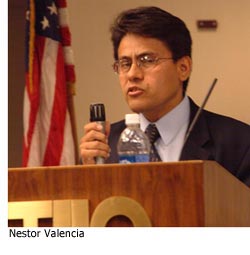 When it comes to Valencia and his group, the city hierarchy doesn’t seem to shy away from exerting its considerable influence in the community, according to documents and interviews.
When it comes to Valencia and his group, the city hierarchy doesn’t seem to shy away from exerting its considerable influence in the community, according to documents and interviews.
In March, for example, the principal of the Martha Escutia Primary Center in Bell says he was supervising more than 200 youngsters on the school grounds outside when he was summoned to the campus office for an “absolute emergency.”
“There was a woman there and she handed me a letter,’’ says Principal Marcus Billson. He says he was directed to “read this now.” On City of Bell letterhead, it accused Valencia of misrepresenting himself as a city employee in reserving a room at the well-respected Los Angeles Unified School District preschool, where the Bell Resident Club had scheduled a meeting. “We want you to be made aware of potential false misrepresentation and are concerned when individuals represent themselves as city employees,” said the letter, bearing the name of the city clerk.
Billson found the letter curious, at best.
“At no time did Mr. Valencia misrepresent himself,” Billson says. In fact, Valencia has a daughter at the school and is a member of the governance council. In Billson’s view, Valencia is “an outstanding young man who is one of my leading parents and is an example of community leadership.” Billson says he wrote a letter to the city to set the record straight.
The principal says he also received an unsolicited visit from a Bell police officer, who introduced himself as the department’s liaison to the school. The officer, wearing a suit and badge, said he was always available for whatever public safety issues might arise at the school. The conversation then took a turn.
The officer said he “was also there to warn me that there were citizens, primarily Nestor, who were very interested in getting into the middle of things in Bell and didn’t know what they were talking about.”
The impact of the policeman’s warning: “I felt like I was being pressured and I knew I wasn’t doing anything wrong.”
In the end, Billson says, the Bell Resident Club meeting was convened as scheduled at the school in mid-March and drew a raucous audience of more than 200. Meanwhile, the principal says he took the officer up on his generous offer to give a public safety talk to parents at the preschool. “I’ve been trying to walk down the middle,” Billson says of navigating the community’s political minefield.
The following month, the Bell Resident Club began moving forward with its plan to invite representatives from Los Angeles County to attend its meeting to explain why property tax bills were skyrocketing. Once again—this time to greater effect—Valencia and his group found themselves subjected to a campaign of misinformation and dirty tricks that included an inflammatory flier purportedly produced by the Bell Chamber of Commerce with the headline: “DON’T BE FOOLED BY LIARS & COWARDS!”
“A faction of evil-doers with a questionable agenda that hides behind the name Bell Residents Club [sic] is spreading lies about our City of Bell,” it says in one typical passage.
Among many other things, the flier—which was distributed at a food bank and a neighborhood watch meeting—accuses Valencia’s organization of “bringing gang members and other unsavory characters to our community” and of being “dangerous and out to destroy your quality of life in Bell.”
For its part, the Chamber of Commerce has disavowed the flier, calling it a fake.
“It was quite shocking to us,” says chamber President Ricardo Gonzalez. “I think it was done in poor taste.” He said the organization has not, however, tried to determine who was behind the screed, which bore the chamber seal. “We try to focus on the positive things in the community.”
As the May 18 meeting grew closer, efforts to scuttle it intensified.
One day before county officials Barrera and Quan were scheduled to show up, a manager of the meeting hall says he got an unnerving call from a man identifying himself as an officer with the Bell Police Department.
“He said not to rent out the room to Nestor Valencia since Mr. Valencia is a very problematic person,” recalls Marcelino Martinez of the AMORC Cultural Center. “He said Mr. Valencia has nothing to do with the city and to avoid problems I should not deal with him.”
Speaking in Spanish through an interpreter, Martinez says he felt threatened by the man’s “tone of voice and the way he was coming down on me.” Martinez, 66, emphasized that the caller did not provide a name, so he cannot be sure he was actually a policeman.
By then it didn’t matter, Martinez says, because arrangements had been approved by the Cultural Center and the meeting was moving forward as planned.
But not everyone, it seems, was ready to throw in the towel.
On the day of the meeting, Valencia says, he suddenly started hearing from residents who’d received phone calls announcing that the meeting was off. “People were calling saying, ‘I hear you cancelled the meeting tonight.” I said, ‘No, No, No.” Valencia suspects that someone obtained phone numbers from a petition he’d filed with the city, calling on Bell to stop issuing bonds that were increasing the tax load on residents.
That night, for whatever reasons, the crowd for Barrera’s and Quan’s presentation was spirited but disappointingly small. “It just fell apart,” says Valencia.
Afterwards, he says he told Barrera of the efforts to undermine his community organizing and handed her copies of the disputed Chamber of Commerce flier and the City Hall “emergency” document that had been hand-delivered to the preschool principal. “This is what happened,” he says he told her. “Normally, we get many more people.”
As Barrera tucked the documents away, she says Valencia “apologized profusely.”
—
As it turned out, Bell’s residents got something more than an accountant, as Barrera had suggested back in May.
They got investigations by the L.A. County district attorney, the California attorney general and the state controller, among others. And they now have the full-time attention of the county auditor-controller’s office, which has found itself swept up in the media storm.
“For more than two weeks the staff and I feel like we’ve been working for the City of Bell—without the big salaries,” says Auditor-Controller Wendy Watanabe.
As soon as the Los Angeles Times disclosed in July that Bell City Manager Robert Rizzo was making nearly $800,000 and that Police Chief Randy Adams was banking twice as much as LAPD Chief Charlie Beck, Barrera immediately thought back to her night in Bell and those extraordinarily high tax rates from bond measures and city assessments.
“When news of the salaries hit, I pulled down my file and said, ‘This is coming back.’ Maybe this is where the bond money was going.”
Since then, Barrera and her team have been studying Bell property tax bills as though they’re forensic evidence, searching for clues and answers to how the city’s tax rate became the second highest in Los Angeles County—especially considering that its population of 39,000 has a median annual income of only $40,556, which is $17,000 below the county average.
Along the way, besides responding to a daily onslaught of media inquiries, the auditors have turned up some eye-catching findings in their examination of property tax bills in Bell and across the county.
One of their studies, for example, resulted in the surprising finding that, in many cases, the county’s poorer cities have been saddled with higher tax rates than far more affluent areas.
Barrera says her team is now undertaking an ambitious effort to examine the top ten cities with the highest levels of voter-approved indebtedness. The goal, she says, is to ensure that those cities are not spending more than the amount stated in local ballot measures.
“I feel energized,” says Barrera, a 24-year veteran of the Auditor-Controller’s Office, who has been in her current job for only a year. “I see a lot of areas I want to look at.”
More scrutiny for public paychecks
August 3, 2010
 Continuing revelations about salary and pension abuses in the city of Bell have stoked popular outrage and served as a wake-up call for elected officials up and down the state.
Continuing revelations about salary and pension abuses in the city of Bell have stoked popular outrage and served as a wake-up call for elected officials up and down the state.
But while Bell officials have largely stonewalled the press and public in releasing key information, the county of Los Angeles has long posted elected officials’ salary and tenure information, as well as a payroll list of all County employee job classifications and salary ranges. However, with department head compensation listed only by salary schedule code—not by name—the public can’t readily determine exactly what they’re paying those top executives.
To shed some light on the issue, Supervisor Zev Yaroslavsky has authored a motion to be placed on the Board of Supervisors’ agenda for August 10. The motion would require that within two weeks the county’s Chief Executive Officer and Auditor-Controller compile, post online and regularly update detailed salary information for all county department heads by name, similar to the posting for the county elected officials.
Meantime, State Controller John Chiang has announced that he will begin collecting and posting detailed local government salary information for the state’s 58 counties and 480 incorporated municipalities.
Posted 8/3/10
Baby, you can’t drive these cars
June 24, 2010
Ah, that old car smell. Step inside the anonymous-looking Gardena warehouse and breathe it in: History. Glamour. Prestige. And a big ol’ steam-powered tractor, complete with dirt-encrusted tires, that Hollywood’s Edgar Bergen drove around his orange grove in the San Fernando Valley.
Stashed away in this unlikely location is one of the country’s most intriguing collections of 75 vintage vehicles, owned by what may seem like an equally unusual collector—the County of Los Angeles.
The county-run Natural History Museum came into possession of the cars when it parted ways with the Petersen Automotive Museum in 2007 as part of a divvy between the two. The Petersen, now a private non-profit institution, kept cars that had been given to its foundation over the years, while the Natural History Museum kept those that had been given to the county by such benefactors as Bergen’s widow, who donated the tractor.
The county collection has been largely off the general public’s radar, although experts and researchers use it heavily and individual cars have been displayed at the Natural History Museum, the Petersen and at other facilities and events.
Now the public is about to get a look. This fall, the museum plans to start offering behind-the-scenes tours one day a month at its Gardena collections facility.
Museum officials also are attempting to refine the collection’s mission—an exercise that includes deciding which vehicles are most important to keep. Their report to the Board of Supervisors is expected by the end of the month.
Will the 1963 Rolls-Royce Silver Cloud III, donated to the county by a Pasadena doctor, make the cut? How about those two rumble seat-equipped Model As? Or the gleaming black 1932 Duesenberg roadster, its imposing body designed at Pasadena’s Walter Murphy coachworks?
Museum officials won’t say which, if any, vehicles may be moving on. But their goal is to focus on vehicles that have a story to tell about Los Angeles and California—especially those that remain in authentic, unrestored condition, with their “cultural DNA intact,” in the words of John Long, the museum’s vice president for research and collections.
“A lot of our cars aren’t wonderfully polished and looking like they’re straight off the showroom floor,” he says.
Some are, of course—like a bright yellow 1927 McFarlan roadster. “It’s totally historically inaccurate, but it’s a gorgeous piece of eye candy,” says the museum’s collections manager, Beth Werling.
The current belle of the garage, however, is an exceptionally rare 1908 Pierce Great Arrow touring car made in Buffalo, N.Y., once owned by the wife of the editor of the San Francisco Examiner. It’s massive and imposing, even regal, with gold monograms on its wine-red doors.
The vehicle is said to be the only one of its kind in original, unrestored condition—something that auto connoisseurs find interesting these days, it turns out.
The Great Arrow’s been invited to participate in the Concours d’Elegance car exhibition in Pebble Beach in August, where Pierce cars will be a particular focus.
“The Concours d’Elegance is the most prestigious car show in the world right now,” Werling says. “Being invited is like being nominated for an Oscar.”
The Concours selection committee is even footing the bill for transporting the car to and from Pebble Beach. “It’s a magnificent car,” says Martin E. Button, who’s on the selection committee and whose company, Cosdel International Transportation, specializes in the import and export of collector cars from around the world.
“It is the only one that is unrestored and in original condition—which is really important…I have a 1909 Pierce Arrow that’s not nearly as rare as this.”
And one of these years—maybe this one—an unrestored car may win big at the Concours.
“We’ve never had an unrestored car win Best of Show, but everybody wants it to happen,” Button says. “We’d love to see that.”
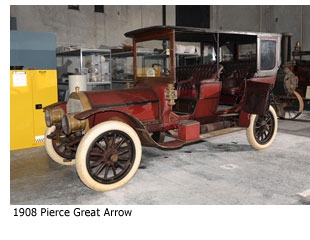 In order to have a shot at rolling over the ramp to a moment of glory in front of the Lodge at Pebble Beach, a car has to actually be drivable, which presents a bit of a problem. The Great Arrow, which was running in 1998 when it previously was exhibited at Pebble Beach as part of the Petersen’s collection, now has a gummed-up carburetor. It’s on its way to a specialty mechanic.
In order to have a shot at rolling over the ramp to a moment of glory in front of the Lodge at Pebble Beach, a car has to actually be drivable, which presents a bit of a problem. The Great Arrow, which was running in 1998 when it previously was exhibited at Pebble Beach as part of the Petersen’s collection, now has a gummed-up carburetor. It’s on its way to a specialty mechanic.
“We’re scrambling to find funding to get it up and running,” Werling says. “We’re not sending it to Pep Boys.”
Werling, who has degrees from Stanford and NYU, also manages Natural History Museum collections ranging from jewelry (“We have Pio Pico’s rosary”) to aircraft (“We have a glider and we have a bi-plane.”) Her previous professional experience with vehicles was limited to tractors at an agricultural museum in Arkansas.
“It’s been a big new world,” she says. “It’s a very complex artifact to take care of.”
As she moves through the collection, Werling points out two types of cars with California links. For some, the connection is obvious—they were made here during the city’s early 20th century burst of automotive entrepreneurial spirit. In this category are the two 1902 Tourists, for example, made by downtown L.A.’s once dominant Auto Vehicle Company.
Then there’s the second category—cars made elsewhere but that reflect something about the California people who made or used them.
Take, for example, the butter yellow 1953 Cadillac Eldorado, to be displayed as part of the museum’s multifaceted Southern California history exhibit “Under the Sun” when it debuts in 2012. The car’s design is the work of the legendary Harley Earl, who was born and raised in Hollywood and went on to fame as head of General Motors’ style department. He got his start in his father’s Earl Automotive Works in Los Angeles, going on to create showy vehicles for Silent Era film stars before Detroit lured him away.
Like the Cadillac, other vehicles have ties to an earlier Los Angeles, a time when local road races became fodder for the era’s moviemakers. The museum’s 1915 Stutz White Squadron Race Car (currently on loan to the Petersen) appeared in an early movie in which a real racecar driver, Earl Cooper, played the love interest to Mabel Normand.
A Jaguar 1954 XK-120 coupe in the collection speaks to Los Angeles’ emergence as a sports car capitol after World War II. “We had the roads that you could drive them on,” Werling says. Those images reached the rest of the country—and the world—by way of Hollywood movies. And the rest, as they say, is history.
When it comes to the stories behind the cars, it’s hard to beat the jaunty red1904 Franklin that staged one of the first cross-county road trips—with Pasadena mechanic Lester Whitman at the wheel—and later survived the San Francisco earthquake. After the quake, as fires raged, the plucky vehicle helped ferry survivors across the bay to Oakland, losing its wicker basket trunk to burning embers in the process.
Now it’s time to present those stories—and the collection as a whole—to the public.
“They’ve got some great cars down there, they really do,” says Button, of the Pebble Beach Concours d’Elegance selection committee. “You have some wonderful cars and I think they’re a real attraction. I just think it’s a real shame to have cars stashed away.”
Focusing on “preservation cars” like the Pierce Great Arrow might be a good niche to develop as the museum refines its collection. “There are no museums that do that,” Button says. “One of the sayings we have, and you can quote it, is: You can’t restore originality.”
By the way, don’t expect any cross-town rivalry from Leslie Kendall, curator of the Petersen Automotive Museum, who says he’d welcome the opening of the Natural History Museum’s collection to the public for tours.
“I can’t get enough,” Kendall says. “I love the idea that there’d be another place I could see great cars.”
Photos by Scott Harms/Los Angeles County
Posted 6/24/10
Restored “Metropolis” is back in town
May 13, 2010
Shortly after its 1927 premiere in Weimar Germany, Fritz Lang’s dense but visionary science-fiction fable “Metropolis” was drastically cut by roughly 40% of its running time in an effort to broaden its audience appeal and earn back the cost of what at the time was the most expensive movie Germany had ever produced.
But over the years, so much additional footage was lost, damaged or recut and mutilated that a bitter and despairing Lang declared that his most famous film “had ceased to exist.” Film scholars dismissed periodic attempts at restoration as only partially successful at best, and “Metropolis” gradually became better known to the general movie-going public as a ghostly legend, embellished with a few striking production photos, more than a vibrant “moving picture” theatrical experience.
But then–astoundingly–in early 2008, a virtually complete 16mm print was discovered languishing in an Argentinian film archive. For less than the cost of an average TV series episode, German film technicians repaired and restored the elements as best they could, recording a new soundtrack of the original symphonic score composed especially for the film.
The full-length “Metropolis” had its long-overdue return engagement at a handful of sold-out film festival screenings, including one earlier this year in Los Angeles. But now the rest of LA’s filmgoing community will have its chance to see the film that influenced “Blade Runner” and countless other science-fiction classics when “Metropolis” opens on Friday, May 14 at the Laemmle Royal Theatre in West Los Angeles.
Silent movie and science-fiction buffs will need no further prompting to start queuing up for tickets. But for the rest of us, visit the Kino International website for the full background of this fascinating film and the torturous path its history has taken. And if you need any additional encouragement, check out the Metropolis trailer.
Posted 5-13-10
On alert for mumps
May 13, 2010
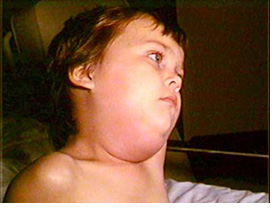 Getting the mumps was once a childhood rite of passage. But it’s rare in modern-day Los Angeles County, where the vast majority of young children are vaccinated against it, along with measles and rubella.
Getting the mumps was once a childhood rite of passage. But it’s rare in modern-day Los Angeles County, where the vast majority of young children are vaccinated against it, along with measles and rubella.
So with nine cases so far this year—six confirmed and four of those in the past two months—the Public Health department isn’t taking any chances. Mindful of an outbreak that started last year in Orthodox and Hasidic Jewish communities in New York and New Jersey, the department is putting out the word that mumps is communicable, potentially dangerous—and preventable.
The county had just seven confirmed cases in all of 2009, the same number in 2008 and only five in 2007, according to Dr. Jonathan E. Fielding, the county’s director of public health. In a public health advisory issued Tuesday, May 11, Fielding said symptoms include “swelling of salivary glands, fever and inflammation of the testes in teenage and adult males.”
He urged those with symptoms to stay out of group settings and see a doctor. And he noted that the best protection against the virus is the measles-mumps-rubella vaccine.
While the vaccine is most commonly given to children, medical officials say adults who have not been vaccinated should also do so.
“A few of the cases seem to have some relationship with the outbreak in the Hasidic community in New York,” Fielding said Thursday. But piecing it all together is a complicated matter of medical investigation. “Somebody came through South Africa,” Fielding said.
Dr. Nelson El Amin, medical director of the county’s immunization program, said there was evidence that some of the L.A. cases “may be related to travel related to Passover.”
“Not all are among the Hasidic population. Some are,” El Amin said.
He declined to be more specific, other than to say the L.A. patients ranged in age from infancy to adulthood and were from the northern and “Metro West” areas of the county.
“I can tell you that the majority of those who got it have not been immunized. I don’t believe any of them have been immunized as kids.”
The Centers for Disease Control and Prevention have been tracking the New York area cases as well as an outbreak at a small college in Iowa and among “a bunch of guys in Omaha” who went to a reunion basketball game and came down with the mumps, among other cases, spokesman Jeff Dimond said. The agency has posted on its website a mumps Q & A and “fast facts” on symptoms.
While the Los Angeles numbers may be small, the level of concern is not.
“We’ve been on heightened alert,” El Amin said. “Our job is to jump on things when there might be a trend.”
Posted 4-13-10
Oh say can you see a 4th without fireworks?
April 19, 2010
Ice cream, sunscreen, nautical flags snapping crisply in the ocean breeze. And as darkness falls, a night sky bursting with fireworks shot from a floating barge as stirring patriotic music fills the air.
Enjoy it while you can. Because in 2011, it looks like the sun is going to set on a long-running L.A. County tradition: the free 4th of July fireworks show in Marina del Rey.
The pyrotechnical display—sponsored by the Department of Beaches and Harbors since the 1980s—is one small budget casualty as the county seeks to bridge a huge $510.5 million shortfall in the coming fiscal year.
“We pay for the shows in advance, so this July 4th show is funded from this year’s budget,” Brad Fleischer, division chief of the department’s Administrative Services Division, said in an email. “There will not be a show in 2011 unless funding is restored or another funding source is identified.”
The $81,000 Independence Day extravaganza certainly isn’t the biggest item on the county chopping block in a year when service cuts and layoffs are looming.
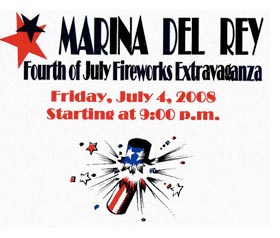 But, with some 25,000 spectators turning out for the fireworks each year, the show occupies an important niche on the area’s public events calendar. Crowds watch from Fisherman’s Village, Burton Chace Park and Marina (Mother’s) Beach, and from as far away as Venice and Playa del Rey.
But, with some 25,000 spectators turning out for the fireworks each year, the show occupies an important niche on the area’s public events calendar. Crowds watch from Fisherman’s Village, Burton Chace Park and Marina (Mother’s) Beach, and from as far away as Venice and Playa del Rey.
“This has been a tradition in the Westside for many years, and from a tourism perspective, it helps bring business into the Marina del Rey/Venice community,” Beverly Moore, executive director of the Marina del Rey Convention & Visitors Bureau, said in a statement. “Some hotels book rooms months in advance specifically for the fireworks, so hotels, harbor tours, charter boat companies, restaurants, retailers and marine services and supplies all benefit from this event.”
“This is the Marina’s big event, this and the Boat Parade,” added Irving Perry, western manager for Zambelli Fireworks, which puts on the show. “This is their biggie of the year.”
The fireworks cost about $30,000, with barge and tugboat costs running $23,750 and traffic and other expenses making up the rest of the budget for the event.
Fleischer acknowledges that the fireworks are a staple of the Marina’s summer season. But he says that the difficult budget outlook, along with increasingly complex safety and environmental issues related to putting on the show, means that the fireworks are “not considered one of the core services that we provide—keeping the Marina clean and functioning.”
Posted 4-19-10
Veggie smugglers, beware
March 31, 2010
In L.A. County’s canine workforce, you’ve got your glamour hounds– dogs who can sniff out a multimillion dollar drug cache faster than you can say “film at 11.” And you’ve got your rough-and-ready patrol dogs—the ones renowned for collaring runaway bad guys in mean back alleys.
But where, oh where is that rare breed of dog who can take down a rogue shipment of dandelion greens, bok choy and parsley? To which the county agriculture department says: Meet Ebony and Tahoe.
The new dogs on the beat, together with their handlers, inspectors Hung Truong and Rogelio Carranza, are the pioneering members of the county’s new Agricultural Detector Dog Program.
Truong and Carranza recently traveled to Georgia for a 10-week course at the USDA National Detector Dog Training Center. There, they met their new dog partners and got to work on illicit produce detection.
The training initially involved teaching dogs to scratch at boxes in which handlers had placed five different fruits—guava, mangoes, stone fruit, oranges and apples. Then “non-target boxes”—containing items like clothes, candy and shampoo—were added to the mix, with treats bestowed on the dogs when they continued to scratch at the fruit-filled boxes in the midst of the other packages.
Since February, the team has been on the job in Los Angeles County, conducting inspections at FedEx warehouses and planning to expand soon into UPS and U.S. Postal Service facilities as well.
The stakes are high. An unwelcome pest that hitches a ride on, say, some homegrown peaches could quickly become established here.
“An infestation of such pests could cost California millions of dollars in crop and job losses, increased pesticide use, and quarantines that impact trade,” according to a new brochure on the program.
“The granddaddy of all pests that we don’t want to have infesting this county are the fruit flies,” says Dave Cassidy, quarantine deputy for the Department of Agricultural Commissioner/Director of Weights and Measures. “By stopping it before it even gets here, that’s the cheapest method.”
The effort is being funded with $311,205 in federal money passed along by the California Department of Food and Agriculture—an arrangement approved Tuesday by the Board of Supervisors. The funding covers all expenses associated with the program, including dogs, training and human salaries.
The team already is earning kudos for its work. Ebony, a Lab mix, was prominently featured in a recent pest report put out by the California Department of Food & Agriculture. In the best just-the-facts style of the police blotter, under the headline “LA County’s New Detector Dog Team’s First Find!” it said:
“On March 5, 2010, at about 8:00 a.m. at the FedEx in Santa Fe Springs, Ebony responded to an unmarked box sent from Arizona.
Inspector Truong and supervisor Carmen Rieger opened the unmarked box and found it contained dandelion greens, bok choy, dill, green lettuce, and parsley.”
What sounded like an innocent salad bar became considerably less appetizing when you learned about the garnishes it was carrying.
“The mixed vegetables appeared home grown and contained ants, aphids, mites, slugs, springtails, wasps, and moths. One of the insects was a big-headed ant (Pheidole sp.) which is a Q-rated pest. The shipment’s contents were destroyed by freezing.”
The discovery came as a shock—not least of all to Truong, who thought he was looking at an olive oil shipment.
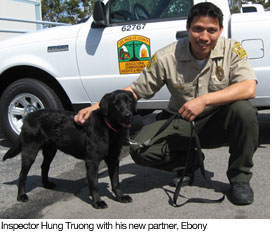 As for her compensation for the big find—“We call it ‘Jackpot,’ ” Truong says. “Instead of one piece of treat, we give ‘em four… They’re working for the treat, but they’re also working for us, so we praise ‘em up. I give her belly rubs, too.”
As for her compensation for the big find—“We call it ‘Jackpot,’ ” Truong says. “Instead of one piece of treat, we give ‘em four… They’re working for the treat, but they’re also working for us, so we praise ‘em up. I give her belly rubs, too.”
Tahoe, a purebred Labrador who weighs in at 70 pounds, has been making his share of finds, too, recently detecting an unmarked shipment of leeks coming from Michigan, according to Carranza, his handler.
It’s important work—and something that humans just can’t do. Unless a produce shipment is leaking, smelly, “taped weird,” or “coming from a high-risk area,” human inspectors have to rely on correct labeling to tell them what to inspect, says Rieger, the teams’ supervisor. But with dogs sniffing out the packages—correctly labeled and otherwise—as they come down the conveyor belt, human inspectors can devote more energy to properly investigating what they find.
“I love it,” says Carranza, 49, a 20-year department veteran. “Right now, I think it’s better with my dog. I’m not alone.”
Posted 3/30/10
An insider’s guide to the Holiday Celebration
December 18, 2009
The Los Angeles County Holiday Celebration is:
a. A chance to get your “Glee” on in the midst of thousands of fellow Angelenos
b. An opportunity to park for free in what is ordinarily a pretty pricey downtown parking lot
c. The only known concert in the world to combine the musical stylings of the Hollywood Master Chorale, Klezmer Juice, the Valleyaires Barbershop Chorus and the Mariachi Divas…along with 41 other acts featuring a total of more than 1,000 performers
d. Your personal gift from the Board of Supervisors–and you don’t have to buy them a tie, fruitcake, or even a bottle of cologne in exchange
You just know the answer has to be e) all of the above. But what you may not know is that this year’s concert (www.holidaycelebration.org) to be held at the Dorothy Chandler Pavilion on Dec. 24, is the 50th anniversary of the festivities started by the late great County Supervisor Kenneth Hahn. So if this is your first visit—or your fiftieth—here’s an insider’s guide to making the most of Los Angeles’ ultimate choir-palooza in its golden anniversary year. (Did we mention that it was free?)
If you go, get there early—or late
Between 8,000 and 10,000 people are expected to attend, so “get in line early,” advises stage manager Chris Christel, a 21-year veteran of the show. The doors open at 2, and the show runs from 3 p.m. to 9 p.m. So get there by 11 a.m. or noon.
A contrarian strategy is offered by Laura Zucker, executive producer of the show and also executive director of the county’s Arts Commission, which produces the Holiday Celebration. “Usually by 7 p.m., the line has dissipated,” she says. She also notes that while early arrivals will have to share the garage with theater-goers taking in the “Mary Poppins” matinee at the Ahmanson, there’s no evening performance—so all those parking spaces will be up for grabs, for free.
Huell Howser—host of KCET’s California’s Gold and known in Holiday Celebration lore for hosting the show by himself for six straight hours in 2001—nods to the after-dark experience. “There’s a whole atmosphere out there on the plaza,” he says. “There’s kind of an excitement about it.”
To pick the best time for your visit, here’s a downloadable program with estimated performance times. Just be warned that the schedule is a bit flexible and acts could start as much as 20 minutes early or late, Zucker says.
So you think you can harmonize
This year’s celebration theme is “It’s Your Turn,” which means that participatory entertainment is the order of the day. Much of the action is out on the plaza, where caroling (song sheets provided), holiday card stenciling, swing dancing lessons and even a Chinese Lion Dance are on tap to entertain the crowd. There also will be a social media station where people can videotape holiday greetings that will be streamed live on www.holidaycelebration.org and www.kcet.org. Here’s the full lineup for the pre-show show.
And once the actual celebration starts, those still waiting to get inside the Dorothy Chandler Pavilion can keep up with what’s on stage by watching the JumboTron that will be set up on the Music Center Plaza. (Yes, kind of like the Gustavo Dudamel inaugural concert at Disney Hall. Not a bad year for access to free music in Los Angeles, eh?)
Make your own favorite memory
With more than 1,000 performers and six hosts—Pat Boone, Tia Carrere, Suzanna Guzmán, James Kyson Lee, Sheryl Lee Ralph and Fred Willard—odds are good that you’ll head home with at least one indelible memory.
Former L.A. mayor and current Superior Court judge James Hahn, who first attended as the 9-year-old son of 2nd District Supervisor Hahn, still recalls some of those early concerts. “I remember the Little Angels choir from Figueroa Church of Christ,” he says.
Maybe your memorable moment will come toward the beginning of the show—say, with the South Pasadena Children’s Orchestra—or at the end, with Mariachi Sol y Reyna de Los Angeles. You’ll know when you hear it.
Veteran stage manager Christel knows fairly precisely when he’ll hear his—around 4:35 p.m. That’s when the ARC Handbell Choir takes the stage. The ensemble of developmentally disabled children and adults puts their all into renditions of holiday standards like “Silver Bells.” “They just seem to take such joy in their performance,” he says. “The ARC Handbell Choir is kind of a tear-jerker for me.”
Go ahead, stay home
Back in the day, James Hahn remembers getting a cool, before-its-time “surround sound” experience by leaving the show and heading home, where he’d listen on the radio and TV simultaneously. Now he could add his laptop to the mix.
So do what Angelenos have been doing since 1965 and watch it live on KCET. Or listen on KPFK 90.7 FM or check out the webcast at KCET.org—all while wrapping presents or sipping eggnog at home.
“It’s one of those traditions that a lot of people keep it on TV for six hours as kind of atmospheric background for the holiday,” Howser says.
A one-hour highlights video of the celebration is made each year and airs nationally on PBS the following year. So next December, you can relive it all again.
And if you can’t wait that long, there’s always TiVo. “As sick as it sounds,” says Christel, the show’s stage manager, “I’ll go back the next day when I’m recovering at home and watch it again.”
Read our featured holiday story, “A holiday ritual for L.A. and the Hahns“
A holiday ritual for L.A. and the Hahns
December 17, 2009
Hundreds of thousands of people have attended Los Angeles County’s free Holiday Celebration over the past 50 years. But for only a select few has it been a command performance.
Just ask Janice and James Hahn.
The children of the late, legendary Supervisor Kenneth Hahn—who created the celebration—always knew what they’d be doing when December 24 rolled around.
“We’d all go down to the Music Center,” says Janice, now 57 and a Los Angeles city councilwoman. “And—I confirmed this with my mother—I would get a new holiday dress every year for this occasion.”
Janice says her biggest memory was when her dad allowed her junior high glee club to perform one year. It was a tough gig to land. The 2nd District supervisor would turn impresario for those early concerts, acting as emcee, overseeing just about every aspect of the performances and serving as all-around gatekeeper. Hahn served as county supervisor from 1952 to 1992, and his musical micromanaging is now part of his considerable legend.
“My dad and his chief of staff were the talent scouts in those days,” Janice says. “They decided who sang and what they sang.”
Musical groups clamored to take the stage, especially when the program moved from the Sports Arena, where it began in 1959, to the Dorothy Chandler Pavilion in 1964. But in the early days, Supervisor Hahn needed to hustle to line up talent for what was then called “The Christmas Music Program.”
And he wasn’t above putting the squeeze on family.
“At first, they didn’t have enough participants so they brought in my uncle George, who was an organist. He loved playing the Sports Arena organ in the gaps” between acts, recalls James, who was 9 at the time of the first concert and went on to become mayor of Los Angeles from 2001-2005. “We actually needed him because otherwise we would have had dead air.”
These days, James, who was appointed to the bench last year by Gov. Arnold Schwarzenegger, is hearing cases involving foster children at the Edmund D. Edelman Children’s Court in Monterey Park. He describes it as “a court unlike any other court” and says the holiday season adds a certain poignancy to what are already difficult times for the children who appear before him.
And when James reflects on the Holiday Celebration started by his dad, it’s his own family recollections that resonate most.
“The memorable times for us were more family moments: When I brought my children down there for the first time, when my sister brought her children for the first time, and then her grandchildren.”
Even now, it’s a hard habit to shake.
“My mother and I, wherever we may be, make a point of tuning in to it, either on radio or public TV,” Janice says.
She thinks the concert has changed for the better over time. “It’s really so much more diverse now, and more inclusive of so many more expressions of holiday times.”
As for all the Twittering, Facebooking and YouTubing that will accompany this year’s festivities, well, let’s just say her father, who died in 1997, preferred to do things old-school.
“I think he probably would have said word of mouth was what carried that program year after year after year.”
It’s been a while since the younger Hahns came out for the free show. “I haven’t been there in a few years,” James Hahn says, “but this might be a good year to go back.”
As for Janice Hahn, she’ll be spending the holidays in Colorado with her grandchildren and will have to miss the celebration. But she’s glad it’s there. As an elected official, she knows how hard it is to keep such programs afloat in challenging economic times. This year, the supervisors had to come up with an extra $100,000 to keep the program, which has a total budget of $900,000, going at its current 6-hour running time. She thanks them for doing so, and for honoring the original vision behind the extravaganza.
“It’s still today part of what he wanted. My father came from a very poor family. He lived in poverty most of his life before he became an elected official. I think that he always felt that this magnificent public building, no matter what your status was, should be free to the public one day a year…He really believed in that one day a year: making people feel like they were special, with no cares in the world, to act like the wealthy–free parking, big luxurious chairs…listening to a glee club perform Jingle Bells.”
“Particularly in times like these, people really appreciate this gift.”

Supervisor Hahn, with one of many choirs, was legendary for micro-managing the selection of performers at the Holiday Celebration
Here’s an insider’s guide to making the most of Los Angeles’ ultimate choir-palooza in its golden anniversary year. (Did we mention that it was free?)




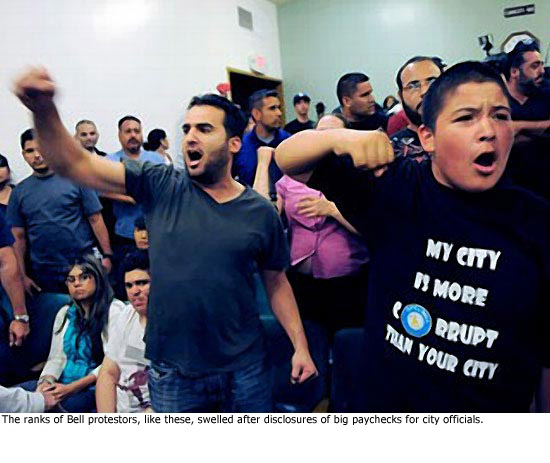
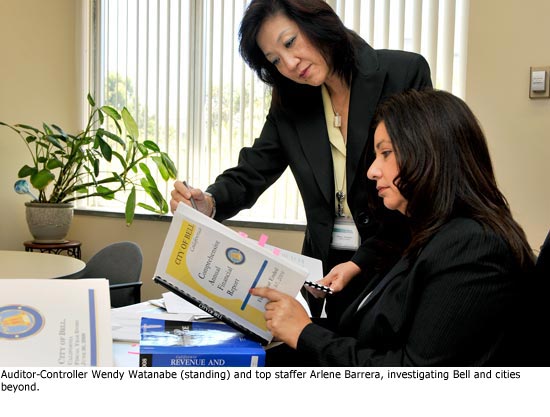
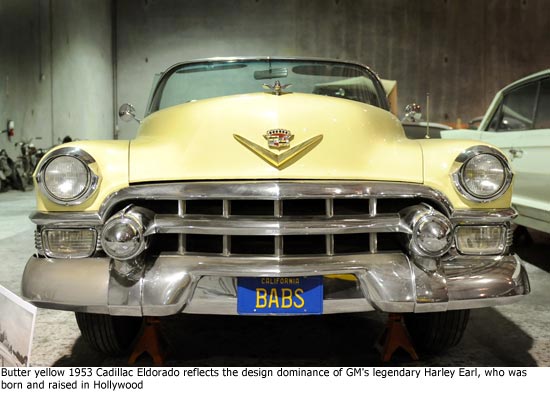
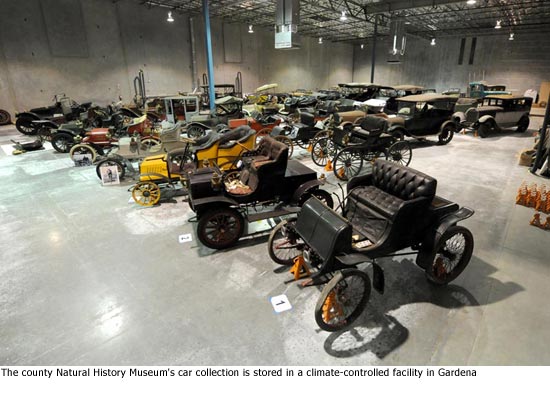
















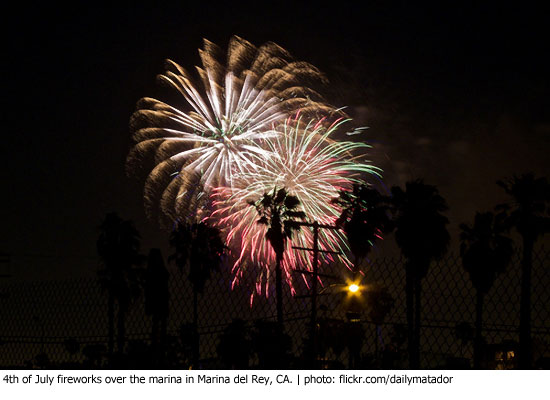

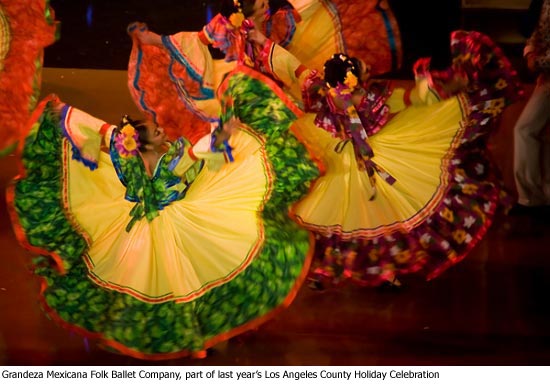






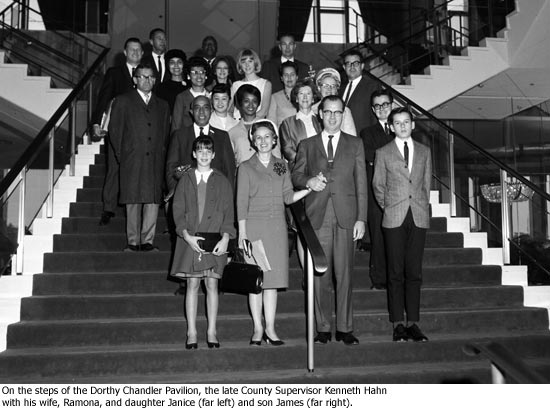
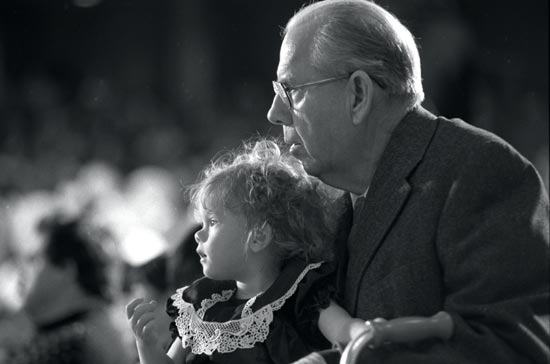








 405 bridge work causes a stink
405 bridge work causes a stink

